2024 B2B Webinar Benchmark Report
Powered by Goldcast
Table of Contents
In the years since we did our first Webinar Benchmark Report, webinars have absolutely exploded in growth.
We think this is due to the surging interest in video content—specifically bingeable content like series—and we don't see it going away anytime soon.
Today, as a forerunner in the webinar space, we're here to help you identify relevant benchmarks and figure out how to improve your webinar strategy to reach more people and get more ROI on your programs.
If you read our first report, you'll recognize a lot of the sections here—although we're working with exponentially more data than we had the first time, making the insights even stronger!
New this year, we'll also talk about webinar series and repurposing, which will shed light on what leading companies are doing to pull as much value as possible out of webinar content.
About the data
To compile this report, we analyzed 6,000+ webinars across nearly 300 different B2B brands. The data spanned from January-December 2023 and included over 1.7 million webinar registrants and more than 613,000 attendees across live and on-demand formats.

What’s a webinar?
We'd like to think everyone knows what a webinar is these days, but definitions are important!
When we say "webinar," we're talking about a very specific type of event: a single-session webinar that lasted 90 minutes or less.
This means that event series, multi-session conferences, two-hour webinars, and anything else outside of those boundaries would not be included in our data.
Webinar types
Goldcast offers three different types of webinar formats:
- Live: This is when you host your webinar in front of a live audience. Even if you record your live webinar for on-demand consumption, it falls into this category if you had an audience there during the actual event.
- Pre-recorded: You also have the ability to record your webinar ahead of time and then release it to your audience on a schedule of your choosing. There's no on-stage audience interaction, but folks can still answer polls, ask questions, and otherwise engage.
- RTMP: This refers to webinars that are streamed in/out externally from other platforms like LinkedIn or Zoom. For example, you might be hosting an event on Goldcast and want it to be available simultaneously on YouTube, so you'd use RTMP.
Live webinars are the most popular
Here's the distribution of these webinar types:
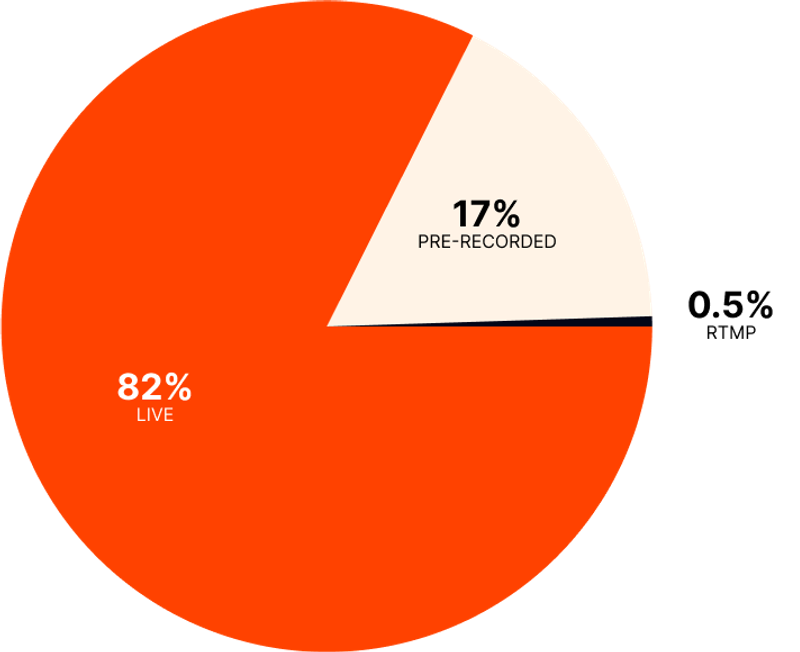
You can see live webinars are by far the crowd favorite, and we think that will always hold true. People are energized by live events and the chance to engage with hosts, presenters, and other attendees!
Why run a pre-recorded webinar?
Pre-recorded events can work well if you have audiences in different time zones and regions, and you only want to host the event once. You can record the initial webinar, and then host it as a "live" pre-recorded event multiple times.
"We play events back as a pre-recorded webinar. We invite people who didn't attend or register before, and bam! They're watching the content, and I didn't have to do any extra work." Logan Fletcher, Events Marketing Manager at Yext
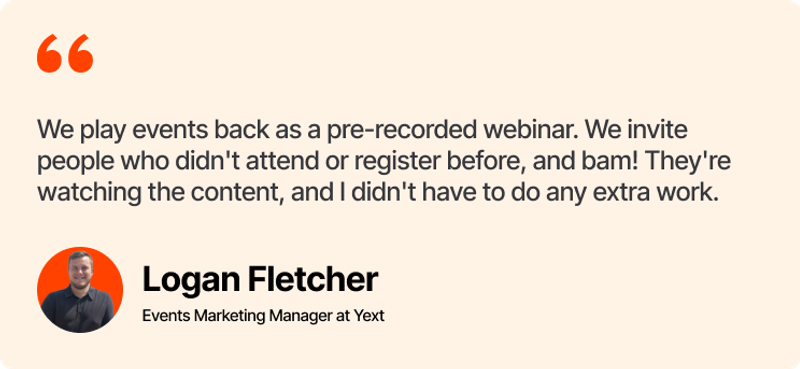
Note that pre-recorded webinars are different from on-demand webinars. They're meant to give the feel of the live event without having the speakers present. While they're not live, your attendees still have the ability to chat, ask questions, and respond to polls—none of that is a part of on-demand content.
Here are some scenarios pre-recorded webinars might make sense:
- You want to run the same event across time zones, and you don't have the capacity to host that many live events.
- You have speakers who can't attend the live event, so you have them pre-record their part so you can play the pre-recorded content during the event.
- You're hosting an event and want all speakers to submit their pre-recorded videos to you ahead of time so you can preview and edit them before the audience sees them.
With pre-recorded content, you have more control over the final product and less moving parts to worry about on the day of the event, which can lead to less stress. However, don't forget that your audience likes to interact with you in real-time! It's best to still offer live events when you can.
What types of webinars are pre-recorded?
We did some digging into the types of webinars that are pre-recorded, and found that these types of formats and topics are most common:
- Product demos and tutorials
- Product roadmap presentations
- Release announcements
- Trainings
These webinar topics make sense for a pre-recorded format. You probably don't want to host 20 different product demos where you're showing the same exact thing, over and over! And hosting pre-recorded announcements and training sessions allows you to maximize the use of your busy leaders' time while still getting some of the benefits of a live event.
Webinar length
In our last report, we only looked at webinars 60 minutes and under. However, for this report, we decided to analyze all webinars up to 90 minutes long because we've seen a recent trend that companies are deciding to extend past the traditional one-hour webinar length.
That said, as you can see below, a majority of brands are still sticking to the 60-minute mark!

Most of our webinars here at Goldcast fall into the 45-60 minute category. We like to allow 30-45 minutes for presenting. We've found this is enough info to be valuable without overwhelming attendees. Then, we open things up and have interactive Q&A with the audience during the remaining time.
Webinar schedule
In our first Benchmark Report, we saw that the majority of webinars happen mid-week. That pattern is still holding strong, with Wednesdays and Thursdays being the most popular days of the week to host events.
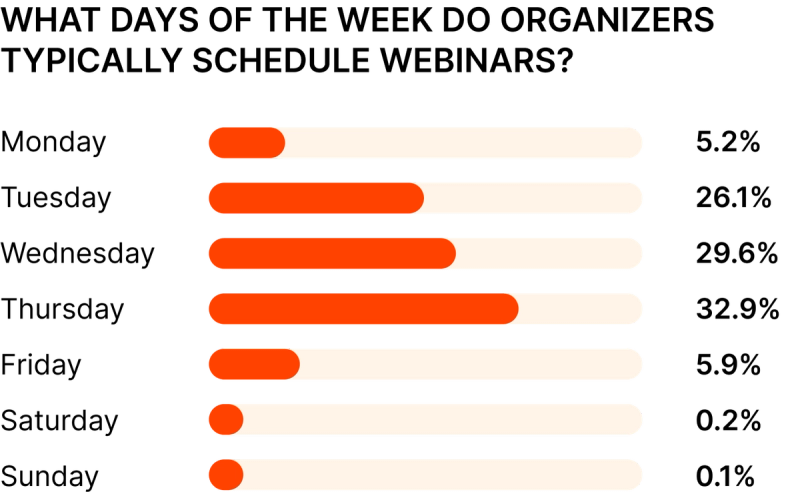
It makes sense to host mid-week webinars because many people use Mondays to map out their priorities for the week, and some folks like Fridays to be a "no-meeting" day.
There are also people who don't work Fridays at all as part of their work schedule, so sticking to Tuesday-Thursday gives you a better chance of attracting them.
Webinar frequency
In the last couple of years, webinar demand and supply has shot through the (virtual) ceiling!
Our first Benchmark Report showed that companies were hosting 13 webinars a year, or about one each month.
Things have certainly ramped up since then!
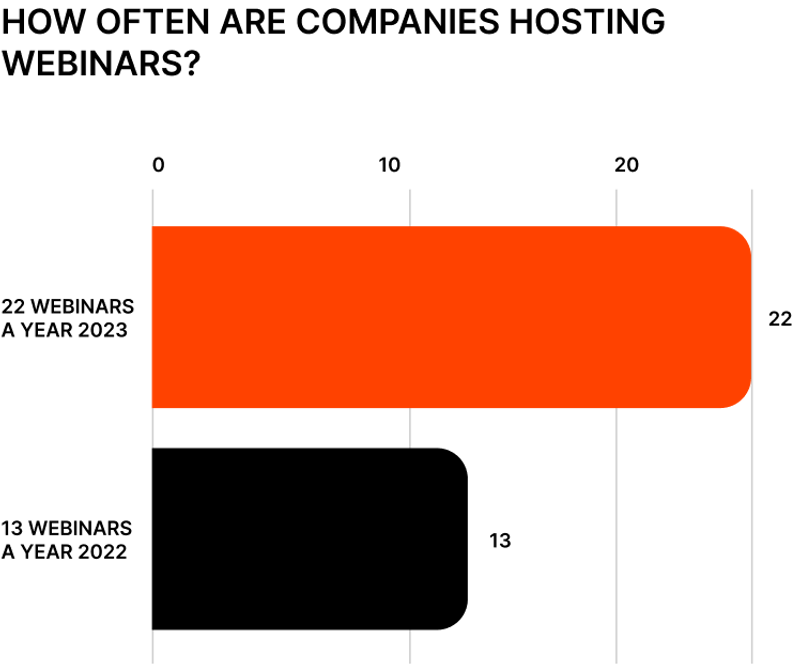
Now, companies are hosting 22 per year—a 69% increase! That's almost two webinars each and every month.
There are a few major drivers of this growth:
- Audiences are craving content, and webinars deliver!
- Platforms like Goldcast have made it easy to produce branded, engaging content and events at scale
- The ability to create event templates makes it a cinch to create a high volume of events, as needed
As we continue to navigate our way through the hybrid and remote-friendly workplace, webinars will stick around as a way for people to connect and get much-needed information. If you've been waiting on a sign to ramp up your programming, it doesn't get much clearer than this!
Webinar registrants
Webinars play a huge role when it comes to boosting brand awareness, expanding reach, producing valuable content for later repurposing (more on that soon!), and lead gen.
And, at least when it comes to lead gen, something is definitely working!
In 2023, there were 1.7 million registrants across Goldcast-hosted webinars.
With that in mind, how many people should you expect to be signing up for each webinar? We used the available data to calculate an average. Take a look below!
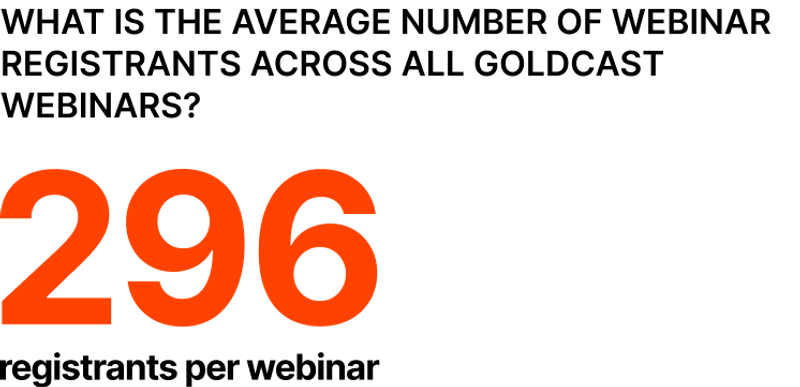
Remember this is just a baseline, and the number of registrants you see per event will depend on the type of event, as well as many other factors. You may skew higher or lower—at Goldcast, our webinars average 401 registrants per event, so we use that as a benchmark when assessing performance.
You should track your registrant numbers over time to see if your webinars are maintaining, growing, or if you need to give your events program a little TLC.
The "Highest Registrants Award" goes to… 🏆
Clocking in with the highest number of registrants for a single webinar—with more than 15,000 registrants!—is Hootsuite's Social Trends 2024: A Glimpse into the Future.
This is a recurring event Hootsuite hosts each year for their ICP, so people can map out their social strategies for the coming year.
Because it's such a landmark event for the company, they pump a lot of time and resources into the promotional strategy. Check out this promo video, full of report insights that the webinar was based on!
Webinar attendance rates
High registration numbers are awesome, but getting people to show up on the day of the event is what really matters in the long run. Having people attend your events is the way you build relationships and continue to grow your brand authority.

On average, we saw a little less than 30% attendance rate when you compare how many people signed up vs how many people showed up. This number has gone down since our last report, when about 50% of people who registered also attended.
Our guess is that with the increased volume of available events, people might be signing up for a lot of different events, even if they can't attend all of them. There are also growing numbers of people who sign up for events and watch them afterward on demand.
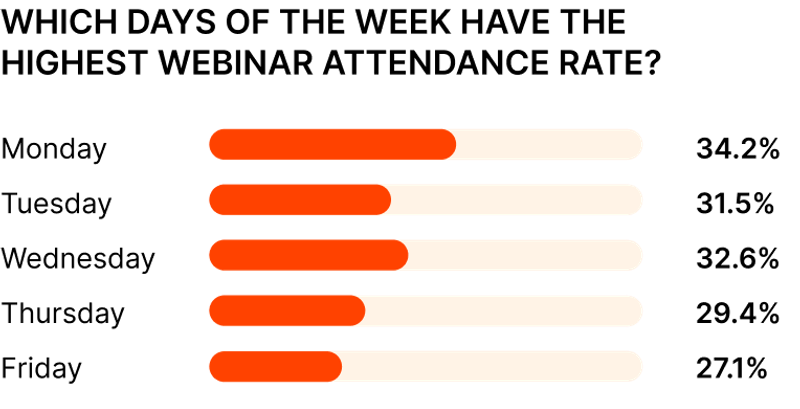
We know that the middle of the week is when the most events happen, but this year we saw an interesting shift. People are showing up to a lot of events on Mondays and Fridays as well.
In fact, the numbers across the week are pretty even. There might be an interesting case to make here about why you should plan more events for the start and end of the week because you'd have less competition!
You can probably guess which event had the most attendees this year!
If you think Hootsuite's Social Trends 2024: A Glimpse into the Future had the most attendees, you're right. More than 5,000 people showed up for the live event!
Important: While that number is the highest we saw, it's also right on track with the stat above—it's a 30% attendance rate when you compare it with reg numbers. So as long as you're seeing somewhere around one-third of people show up, you're right in line with the best of the best!
On-demand webinars
You might think it's a given that every live event is available on demand, but think again.
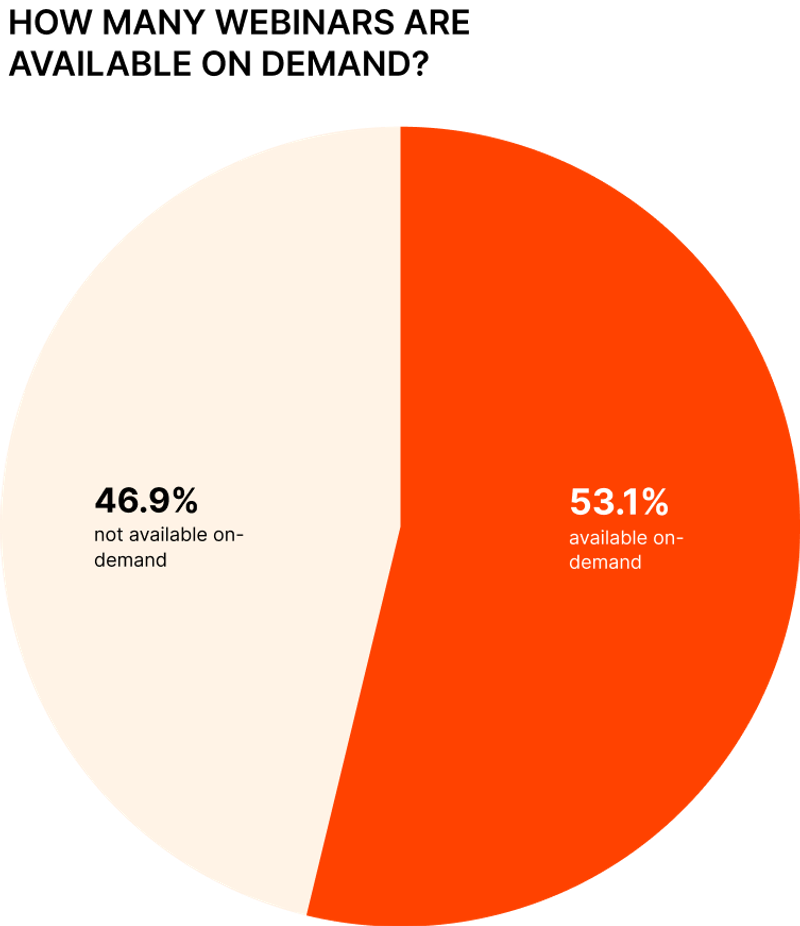
Out of the webinars that are available, a healthy number tunes in to watch the on-demand content, and a handful of those were event registrants who may or may not have attended the live event.

Next, we looked at whether there's a relationship between how many people sign up for an event and its on-demand availability. Are folks more (or less) likely to sign up if they know there will be a recording?

It appears that the registration numbers for webinars that aren't available on demand is slightly lower. Sometimes, people can be swayed to sign up for an event if they think the content is valuable, even if they can't attend—because they know they can watch after. That same draw isn't possible if you don't host your event content in an on-demand library afterward.
On the flip side, the average attendance rate is just slightly higher for the webinars that aren't available on demand. Perhaps there's a small argument here to play on people's FOMO? If they don't attend your event, they won't be able to access the content afterward, so maybe more people that registered will show up!
Webinar series
In a world filled with Netflix, Hulu, MAX, and myriad other streaming platforms, people want to binge your content. Webinar series make that possible!
"People buy a piece of software for 20% of what it can actually do. It's up to the company to do things like series that help people really fall in love with the product and not be able to let it go." James Buckley, Guest Speaker, Host & Sales Content Creator, Sell Better Daily Sales Show
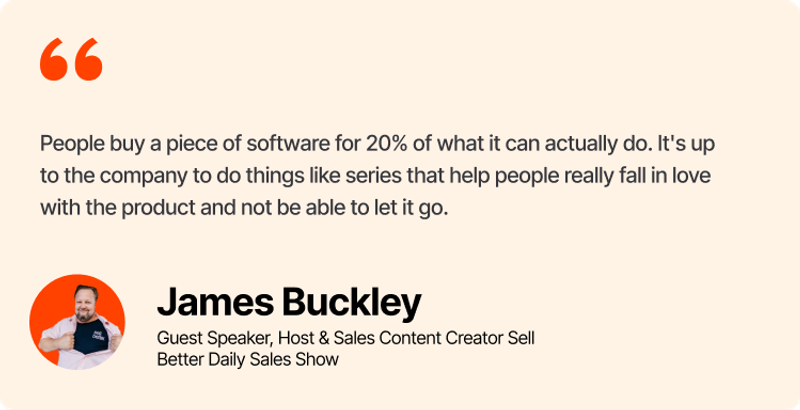
Whether it was a closed series (where you have a preset number of episodes, like our LinkedIn Masterclass Series) or an ongoing series like our Goldcast Insider webinars, we saw a big uptick in event series this year, even on our own calendars!
We believe in series so much that we created built-in functionality to make it easy to set up and maintain your series over time.
And we even did an event series on series, if you want to get really meta about it!
The benefits of a webinar series
Series allow you to go deeper on a theme and build consistency and momentum with your audience.
During our Series Masterclass, Mike Taylor from BambooHR shared that one of his series currently brings in an average reg number of 1,460—truly impressive!
Here are some major benefits of hosting a series:
- You get the chance to become more of a thought leader around specific topics.
- You align your brand more closely with your content. When people think of you, they'll immediately call to mind your series content because they're seeing more of you, more often.
- You connect with buyers long before they're ready to buy, which is key in today's purchasing landscape.
- You can go super niche, which can be fun!
- You generate a ton of content that you can repurpose to fuel your content strategy.
- There's a chance to partner with other brands to expand your reach and learn from each other.
Typically, you're not doing any direct selling during your series events; you're just building relationships and keeping yourself top of mind for your audience through engaging, entertaining (but still valuable) events.
5 successful series examples
Let's look at a few series examples and study what they're doing right!
While Birdeye has a number of webinar series, we're drawn to the company's AI Success Series in particular. This content works for a number of reasons. First, it's timely—marketers have AI on their minds more than ever lately, and they're looking for ways to cut down on overwhelm.
With topics like "Leveraging AI in social media" and "How AI can multiply your Google reviews," Birdeye positions itself as a trusted, helpful resource on AI. And if you can't attend a webinar in person, they make it available on demand via a gated page.
It used to be newsworthy for a company to get hacked, but these days it seems like we get an email every other week that our data may have been breached. Yet, hacks are still extremely costly to companies.
In Rapid7's series, they shared key considerations around cybersecurity with industry leaders, as well as actionable tips for change. There were three total sessions, which took place across a three-month period, and now folks can get instant access to the recorded sessions.
Throughout four sessions, different tech experts taught the audience how to use Trino and SQL. Each session was an hour and built on the one before it, and registrants had a clear idea of what to expect from each webinar thanks to the registration page.
We run a number of series, but we'd be remiss not to shout out our Series Masterclass here!
Start here for the first session, and hear from different founders and marketing leaders about why every department should have a series, how to develop and launch a series, and how to measure your series' success.
5. Ontra's Firm of the Future
Ontra offered a three-part webinar series for asset managers looking to uplevel in an uncertain environment. Each webinar featured a different leader who spoke about how asset managers could continue finding their edge and how technology can help.
You can see that each of these series examples provides something of value for the company's ICP, offers a handful of sessions spaced out over a period of time, and is available for on-demand viewing long after the series concludes.
Naming your event series
You may remember a finding from last year that revealed a negative correlation between using the word "webinar" in your event name and total registrations.
We wondered: Does the same finding hold true for series?

Interestingly enough, it appears that using the word "Series" in your series title can draw more people to sign up. This is a strong sign that audiences like serial content and want to see more of it, so don't be afraid to let people know your series is, in fact, a series!
Webinar in title
Remember, however, that the negative relationship between using "webinar" in your title and registration numbers still stands for now.
In our last report, companies that used "webinar" anywhere in their title saw almost a 50% drop in registration compared to events that did not.
Brands certainly got the memo this time! Only 103 webinars (less than 2%) used the word "webinar" in their titles last year.
Webinar engagement
The more that attendees engage with your event, the better the experience is for everyone.
You can be pretty certain that if your chat is on fire, people are reacting to comments left and right, and you've got some handraisers, people are hooked on your webinar content!
"The chats have been going wild in a good way! We're thrilled with the level of questions and engagement on Goldcast." Nicole Grunt, Global Virtual Events Manager, Brandwatch

Engagement is important for a number of reasons:
- It helps guide your future content and reveals whether your topics are relevant to your ICP
- High engagement numbers show there is high value to your webinar programming
- You can use individual engagement data to identify hot leads and bolster follow-ups
- Engaged audiences are more likely to feel positively about your brand and spread the word about your events
How can Goldcast attendees engage during webinars?
The Goldcast Engagement Panel is where attendees can engage during each event. We capture every data point for you, so that your team can craft personalized notes to go out afterward!
Here are some of the ways your attendees can engage:
✨Chatting with other attendees to share text, emojis, or even GIFs
✨Sending 1:1 messages and/or calls to other attendees
✨Participating in polls
✨Asking questions via the Q&A feature
✨Exploring documents, resources, and CTAs
We found that most Goldcast clients are offering the chat feature, at a minimum. From there, the most popular engagement avenue was providing resources for attendees to click on during the webinar.

However, judging from the numbers below, it might be worth including more polls in your webinars! People appear to be quite responsive to polls when they're available. Try sharing the results after to drive even more engagement with your audience.

*These actions can be taken more than once by each attendee.
Did you know: Goldcast provides an engagement score?
For every webinar you host on Goldcast, we collect 20 data points on each attendee. We also come up with a final engagement score after the event, based on scoring criteria you can customize.
The final score ranges from 0-10 and is based on the following factors, ordered from most to least weighted:
- Q&A asked (most weighted)
- Resources clicked
- Time spent in session
- Poll participation
- Time spent in event (least weighted)
So, if someone asks a bunch of questions, that person's engagement score will be pretty high. It's a good indicator that someone is interested in your brand if they're firing off questions left and right during your webinar!
Once calculated, each engagement score is sent to your integrated platforms so that sales and other teams can use the engagement score to decide next steps.
Webinar repurposing
Once you've done the hard work of creating and executing an event, you can continue to pull value from it by repurposing the content and using it to fuel a multi-channel distribution strategy.
Watch as Lauren Creedon, our VP of Product, walks through a real-world example of how the Goldcast team uses Content Lab to repurpose series episodes:
You can do this, too!
Each webinar you host can be repurposed into short video clips, email follow-ups, social posts, takeaways, and more.
In this moment, as marketing teams look for ways to do more with less, repurposing is critical—it allows you to get the most out of your investment while reaching new audiences and building brand awareness.
How are brands using Goldcast Content Lab to repurpose webinars?
Note: Our data regarding webinar repurposing was pulled from more than 100 brands using Content Lab from July-December 2023.
If you aren't familiar with Content Lab, it's time to get acquainted! Content Lab is our AI video repurposing solution that turns webinars, events, and podcasts into snackable, multi-modal content. B2B marketers from companies like ClickUp and Intercom use Content Lab to boost traffic, enrich content with multimedia, and amplify brand reach!
First, let's talk about repurposing webinars into video. Audiences are craving video more than ever before, and brands are repurposing to meet that demand.
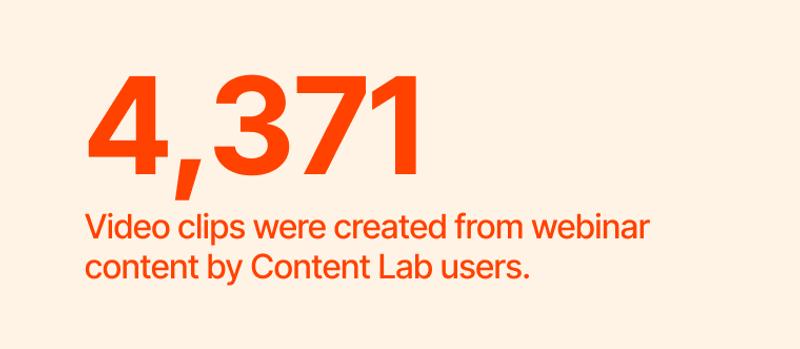
Content Lab offers a few different video formats:
Speaker videos are the most popular and showcase one speaker at a time (vs the grid style, which we'll show next).
https://drive.google.com/file/d/1vpBxsG1_BLqZaEsFgbCWt5WN7Stx3lEP/view?usp=sharing
Grid layouts include two or more speakers sharing space on the screen. This format can be useful if you want to see all parties involved in the talk, at the same time.
https://admin.goldcast.io/shared/clip/d233097a-0eb1-48c1-ad8e-96fbf1238e4e
Audiograms are clips with audio of the speaker, but the visual is a still image of that speaker instead of the video footage.
https://drive.google.com/file/d/1Bdg4utrwGKysWMvdJTpHrnvIZru220NL/view
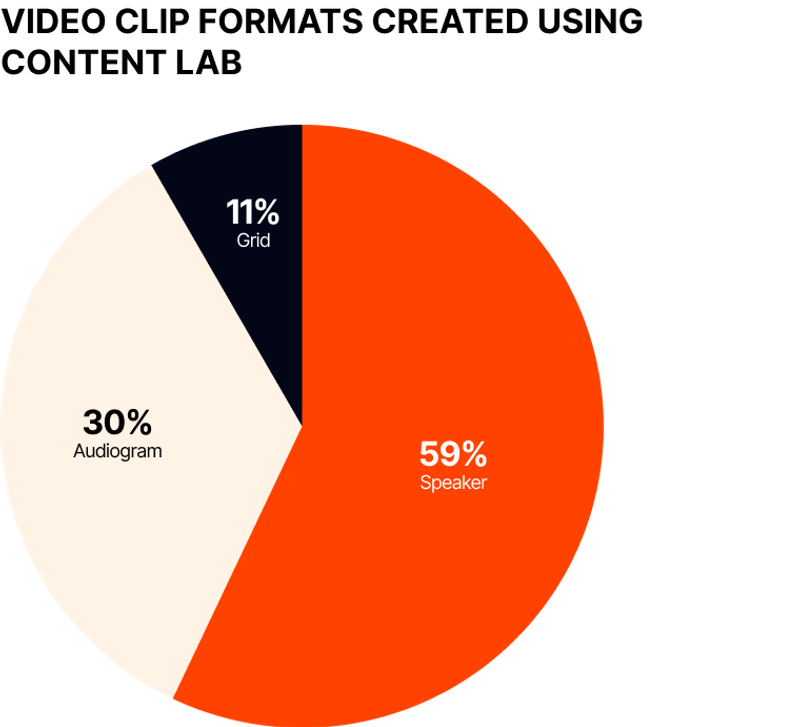
Next, let's look at text assets!

Companies are definitely using Content Lab to spin up text assets—primarily blogs and takeaway posts, although social posts aren't far behind.
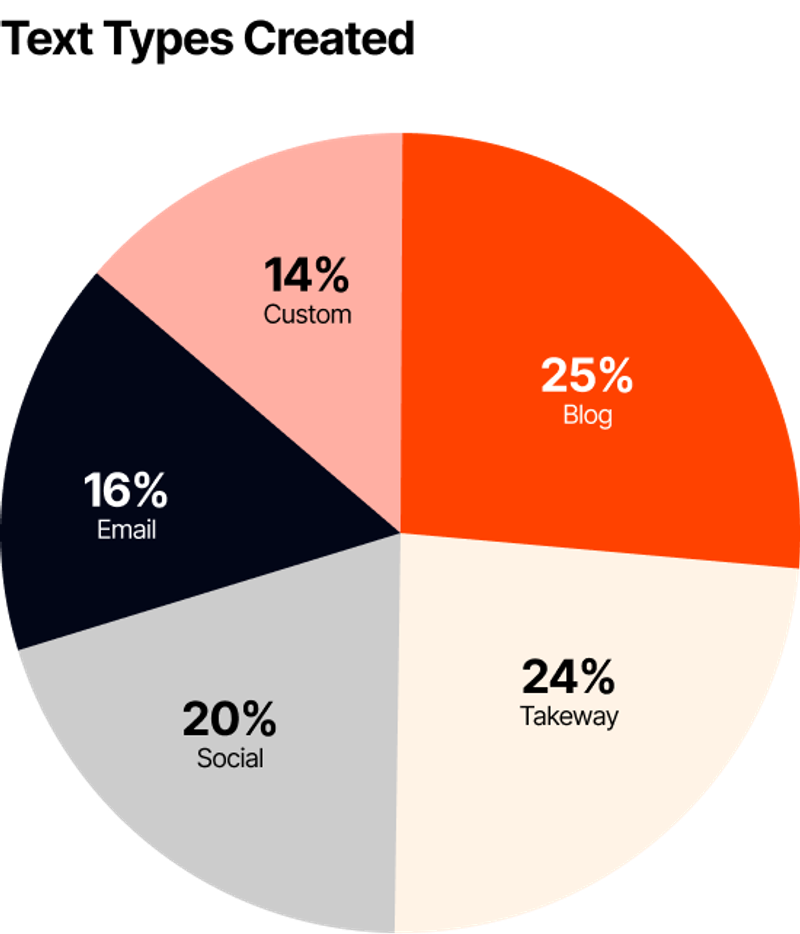
We recommend always using any kind of AI tool as a first draft and not your final product—think of Content Lab as an entry-level marketer on your team, there to help you get started and take some of the tedious work off your plate. The content will still need your expert eye on it before going live!
Webinar Benchmark Scorecard
We've gone over a lot of data in this report, so we're going to recap here so you can have a scorecard to benchmark your own data against.
While your rates may differ depending on your company and industry, the numbers below represent the averages we saw in 2023.
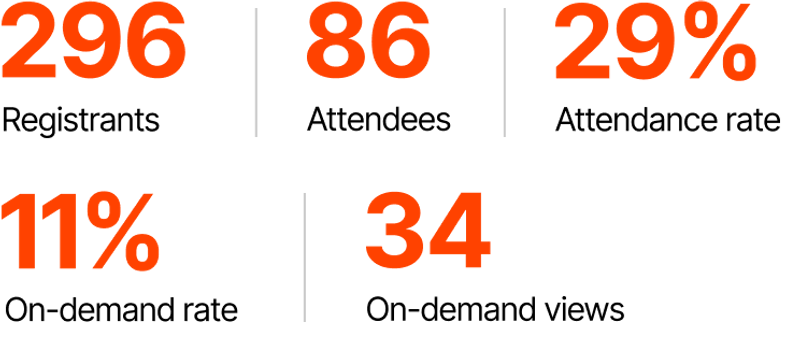
Improve your webinar strategy
This is an exciting time for marketers. With the help of AI, we're able to do more with less and truly scale our efforts. Webinars are an important piece of that! Consistently hosting webinars is a great way to connect with your audience and grow your brand. And afterward, you can host the content on demand and repurpose it to get even more runway out of each webinar.
Our hope is that this report has sparked an idea (or two, or more) for your company's future webinars. Maybe you'll experiment with how often you host webinars or analyze your existing data against the scorecard. Perhaps you want to try your hand at a series or see how repurposing might work for you after your next webinar (you can try Content Lab for free, you know!).
Whatever your goals, we'd love to show you what Goldcast can do for your brand! Whether it's using Goldcast Core to transform your events or trying Content Lab to repurpose your webinars into tons of different assets, we hope you'll sign up for a demo today.

Stay In Touch
Platform
Resources
© 2025 Copyright Goldcast, Inc. All rights reserved.





 Upcoming Events
Upcoming Events Event Series
Event Series On-Demand Events
On-Demand Events

